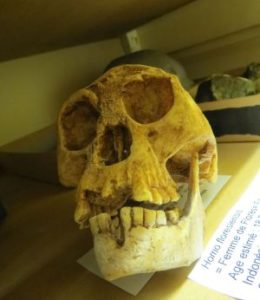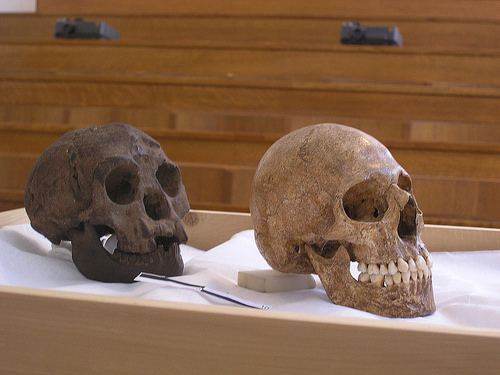
MIDWESTERN UNIVERSITY—Analysis of a wealth of new data contradicts an earlier claim that LB1, an ~80,000 year old fossil skeleton from the Indonesian island of Flores, had Down syndrome, and further confirms its status as a fossil human species, Homo floresiensis.
From the start, fossils of a tiny population of human-like creatures from Flores (the so-called “Hobbits” of Southeast Asia) have been controversial. Are these remains evidence of a new species of fossil human, Homo floresiensis? Or are these remains simply a population of small-bodied humans (Homo sapiens), like ourselves, but with one or more individuals suffering from a developmental disorder? Researchers recently diagnosed LB1, the most complete individual recovered, with Down syndrome.
New analysis of features from across the skeleton by an international team of researchers led by Karen Baab, Ph.D., Assistant Professor of Anatomy at Midwestern University in Glendale, AZ, convincingly demonstrates that LB1 did not have Down syndrome. In addition to measuring individual bones, the scientists used CT scanning to reconstruct the brain and view internal structures of the skull, as well as assessing the 3-dimensional (3D) shape of the skull.
The study*, titled “A Critical Evaluation of the Down Syndrome Diagnosis for LB1, Type Specimen of Homo floresiensis,” is published in the June 8, 2016 edition of PLOS ONE.
Down Syndrome
The diagnosis of Down syndrome is the most recent in a long line of diseases attributed to this particular skeleton. Down syndrome is a chromosomal disorder characterized by cognitive delays and often certain physical features, including reduced stature and brain size. The original diagnosis also emphasized the wide and short (front-to-back) shape of the skull, shape of the chin, and short femur (thigh bone) in LB1 as evidence of Down syndrome. Diagnosing Down syndrome in fossils is complicated by the fact that many common features are found in the soft tissues of the body, which do not fossilize. Nevertheless, this study provides new information about the size and shape of the brain and skull in the Down syndrome population.
Down Syndrome Diagnosis a Bust
For the current study, the team compared physical traits preserved in the skeleton of LB1 to those found in Down syndrome. While people with Down syndrome are not identical to one another, it was nevertheless clear that LB1 was very distinct from all humans, including those with Down syndrome.
The study found that LB1’s brain was much smaller than that seen in Down syndrome individuals. Likewise, the shape of the skull vault, which surrounds the brain, and chin anatomy were both outside the range seen in humans, with or without Down syndrome. Moreover, the diminutive LB1 individual, estimated to be just over a meter (1.09 m) in height (or 3′ 7″), was well below the height range of comparable individuals with Down syndrome. In fact, females with Down syndrome from Turkey reach a comparable height as the adult LB1 by 6.5 years of age and are considerably taller as adults (1.45 m or 4′ 9″ on average). The femur is disproportionately short in LB1 relative to the feet and arms compared to all humans, regardless of whether they have Down syndrome.
________________________________________
Profiles of the midline of the skull as seen in an x-ray or CT scan for people with and without Down syndrome as well as LB1, the type specimen of Homo floresiensis. The differences between the two groups of humans are minor compared to the very distinct shape of LB1. Credit: Courtesy of the study authors
___________________________________________________
One theory has explained Homo floresiensis as a modern human who was deformed by encephalization—a shrunken cranial capacity. The Homo floresiensis skull (left) compared to a skull of a modern human encephalized skull. Avandergeer, Wikimedia Commons
_________________________________________________________
LB1 Remains are the Type Specimen of Homo Floresiensis
Importantly, this study indicated that LB1 not only differed from individuals with Down syndrome, but was more clearly aligned with more archaic human species. Its small brain, low cranial vault shape, absence of a chin, smaller body size and limb proportions all point to a pre-Homo sapiens ancestry. The authors conclude: “The skeletal evidence overwhelmingly contradicts a diagnosis of Down syndrome. Rather, our study is yet further evidence that Homo floresiensis was a distinct species with a fascinating, if somewhat nebulous, evolutionary history.”
Source: Midwestern University subject news release.
Cover image, top left: Skull of Homo floresiensis. Scail Lyna, Wikimedia Commons
______________________________________________________
*Karen L. Baab, Peter Brown, Dean Falk, Joan T. Richtsmeier, Charles F. Hildebolt, Kirk Smith, William Jungers. (2016) A Critical Evaluation of the Down Syndrome Diagnosis for LB1, Type Specimen of Homo floresiensis. PLOS ONE.
______________________________________________________

______________________________________________
Travel and learn with Far Horizons.
____________________________________________
This richly illustrated issue includes the following stories: Recent findings shedding new light on the whereabouts of the remains of Philip of Macedon, father of Alexander the Great; how an archaeologist-sculptor is bringing bones of the dead back to life; archaeologists uncovering town life at the dawn of civilization; an exclusive interview with internationally acclaimed archaeologist James M. Adovasio about what makes the Meadowcroft Rockshelter prominent in the ongoing search for the first Americans; what archaeologists are finding at the site of the ancient city of Gath, the home town of the biblical Philistine giant, Goliath; and how scientists are redrawing the picture of human evolution in Europe. Find it on Amazon.com.








